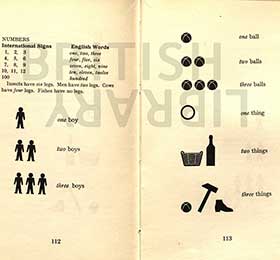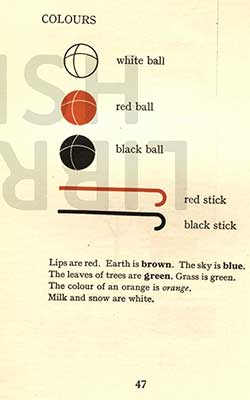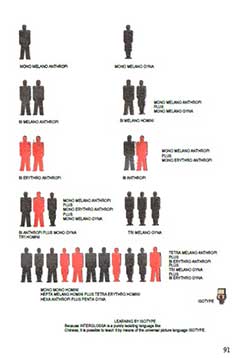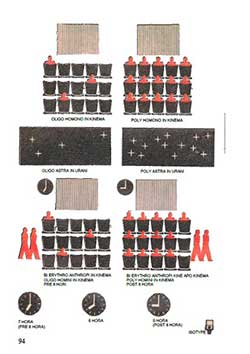
Logical Empiricism and Knowledge
Visualisation: Isotype as a Universal
Language for Social Statistics
- Başak Aray
_______________________________

Fig. 10. O. Neurath, Basic by Isotype, 1937, pp. 112-113 

Fig. 11. O. Neurath, Basic by Isotype, 1937, p. 47 

Fig. 12. L. T. Hogben, Interglossa, 1943, p. 91 

Neurath was aware of his common concerns with Ogden and praised Basic English as a good example of terminological reduction, to which he was himself inclined [7]. Some publications of the Isotype Institute were written in Basic English. Neurath also collaborated with Ogden's work by preparing Basic by Isotype, a visual glossary for Basic. In this book Isotype was used for teaching Basic words. Consistency in the choice of symbols, minimalist pictograms and their restricted number help create a clear visualization of abstract words. Contrast in repeated examples becomes more visible in a consistent picture system.
Teaching of colour-words in Basic by Isotype uses the technique of repetition of otherwise identical pictograms, in order to highlight the difference which corresponds to the colour-words indicated next to each pictogram. Consistency of the system and minimalism of symbols allow an easy detection of the common element in these 3 pictures of balls (fig. 10), so that the corresponding verbal element is associated with it, namely “ball.” Figure 11 shows red and black sticks: the comparison of these two groups highlights the common elements, such as “red,” so that pictures teach the colour names unambiguously. Categories of size and form are also made explicit by making all other things equal. A concern for minimalism leads to the elimination of irrelevant details, which helps to deliver the message clearly.
Interglossa
Principles of reductivism and consistency are also used in another project for an international auxiliary language of Neurath's time. Lancelot Hogben's Interglossa was taught as “an auxiliary for a democratic world-order”: the title reveals a social concern similar to Neurath's. For the purposes of precision and ease of learning, Interglossa was designed as an analytic language, lacking the inflexions of many European languages. Instead, Hogben prefers recognizable, fixed units of meaning. Reduction to units increases accessibility, but its main advantage is optimization for visual aids. Indeed, the handbook of Interglossa contains applications of Isotype to the teaching of the vocabulary. Hogben justifies his preference for an analytic language over an agglutinative one by emphasizing the possibility of using a picture language as a considerable benefit for an international auxiliary language [8].
Figure 12 introduces twelve new words in Interglossa with the help of two pictograms and two colours. The identity of a pictogram across its different uses clarifies the meaning of the associated words. The variation in numbers and colours repeated in different contexts helps the viewer get a clear idea of the words. For example, considering the similar structure of bi melano anthropi and bi erythro anthropi, one can spot the difference in verbal descriptions and associate it with the only obvious difference in the pictures: the colour.
Figure 13 teaches fifteen new words with the help of five pictorial symbols. Comparing the first two images, one spots the difference between them and associates it with the variation in their verbal counterparts: oligo and poly, which mean respectively “a few” and “many.” The following comparison accentuates the opposition between oligo and poly. The same pictogram of two moving red men illustrates two opposing prepositions, a and apo: the image on the left depicts two people entering a movie theatre and the image on the right is the exact repetition of the same scene except for the location of the two men, who are depicted as going out of the movie theatre. The repetition of the same image makes it easier to notice the difference between them and efficiently teaches the new word.
Like Neurath, Hogben sees in the language of science an important material for universal communication. He accepts the continuity between everyday language and scientific language, which is especially due to the increasing introduction of technical expressions into ordinary language. This situation results from the globalization of science, including its products and its whole linguistic culture. Indeed, most scientific terms are not only international, but also universal in the sense that they are used by everyone in everyday language due to the growing place that technology is taking in modern times [9]. And they are traditionally constructed from Greek and Latin words, but Greek roots are usually more current and more familiar than their Latin counterparts. Another reason in favour of borrowing words from a dead language is their cultural neutrality, which is lacking in any of the existing natural languages. Also the compositionality and the rational construction of scientific terms from these roots suit the purpose of an international auxiliary language, which aims to be economical: indeed, by combining Greek roots a great number of new words are constructed, and the transparency of their construction makes them clearly accessible. Concerning the use of natural languages, learning Interglossa also allows a better understanding of scientific concepts through the knowledge of their semantic components, and discovering the meaning of new words becomes a playful activity. Inciting the reader to discover relations in a chart by using an attractive visual medium was a similar concern in the design of Isotype charts.
Conclusion
As an alternative to verbal language, Isotype aimed to be a democratic medium of communication and embodied logical empiricism's cognitive values like universalism, intersubjectivity and democratic accessibility. Its concern for mutual understanding was shared by the movement for an international auxiliary language, two of whose practitioners, Ogden and Hogben, Neurath closely collaborated with. The three auxiliary languages shared principles of reductivism, consistency and familiarity. They all tried to reach as large an audience as possible by empirical reduction and insisted on the universality of scientific language as a model for international communication.
Bibliography
Hahn, H., Neurath, O. and Carnap, R. 1929, Wissenschaftliche Weltauffassung: der Wiener Kreis, Transl. The Scientific Conception of the World: The Vienna Circle, Reprinted in Neurath 1973, pp. 299-318.
Hogben, L. 1943, Interglossa. A Draft of an Auxiliary for a Democratic World Order, Being an Attempt to Apply Semantic Principles to Language Design, New York: Penguin Books.
Hogben, L. T. 1969, The Vocabulary of Science, New York: Stein and Day.
Neurath, O. 1925, Gesellschafts- und Wirtschaftsmuseum in Wien, Transl. The Social and Economic Museum in Vienna, Reprinted in Neurath 1973, pp. 214-217.
Neurath, O. 1932/33, “Protokollsätze,” Erkenntnis 3, 204-214, Transl. Protocol Statements, Reprinted in Neurath, 1982, pp. 91-99.
Neurath, O. 1941a, “Universal Jargon and Terminology,” Proceedings of the Aristotelian Society, N. S. 41, pp. 127-148, Reprinted in Neurath 1982, pp. 213-229.
Neurath, O. 1941b, “The Danger of Careless Terminology,” The New Era: Journal of New Education Fellowship.
Neurath, O. 1945, Visual Education: Humanisation versus Popularisation, Reprinted in Neurath 1973, pp. 227-248.
Neurath, O., Neurath, M. and Cohen, R. S. (eds.), 1973, Empiricism and Sociology, Dordrecht: D. Reidel.
Neurath, O., Cohen, R. S. and Neurath, M. (eds.), 1982, Philosophical Papers 1913-1946, Dordrecht: D. Reidel.
Ogden, C. K., 1936. Basic English and Grammatical Reform, Reprinted in Ogden 1994, pp. 187-226.
Ogden, C. K. and Gordon, T. W. (ed.), 1994, From Bentham to Basic English, London: Routledge.
[7] “Whether you like this remarkable piece of work or not, it at least teaches you the lesson that one can essentially reduce the variety of our vocabulary with a surprisingly small sacrifice of the variety of the subject matter” (Neurath 1941b).
[8] “An isolating language has a further advantage. It is easy to make every element explicit through visual aids. Thus freedom from lifeless affixes simplifies the task of instruction through the medium of the universal picture-language isotype without recourse to exposition in the home vernacular. We can therefore contemplate production of manuals for a world-wide market” (Hogben 1943, p. 17 [footnote]).
[9] “In all countries where modern medicine, modern plumbing, modern agriculture and modern engineering penetrate, the vocabulary of science speedily makes its impress on daily speech. What was yesterday the jargon of the expert becomes an ingredient of the vernacular. Thus scientific nomenclature is international in a dual sense. It is everywhere the vocabulary of the expert and its components are daily invading the speech habits of widely separated communities” (Hogben 1969, p. 4).


